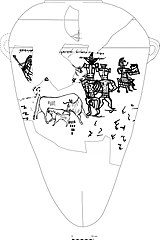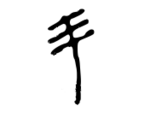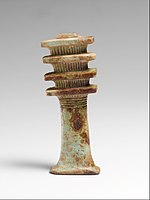

The Kuntillet Ajrud inscriptions describe art featuring Yahweh found on and near two jars and other media. They were found at a unique Judean crossroads location that was among an unusual number and variety of vessels and other inscriptions.[4] They date to the late 9th century BC[5] in the Sinai Peninsula.[6]

The finds were discovered during excavations in 1975–1976, during the Israeli occupation of the Sinai peninsula, but were not published in first edition until 2012.[8][9]
The "shocking" and "exceedingly controversial"[10] inscriptions have been called "the pithoi that launched a thousand articles"[11][unreliable source?] due to their influence on the fields of Ancient Near East and Biblical studies, raising and answering many questions about the relationship of Yahweh and Asherah.
The most famous[12] inscriptions are found on two pithoi,[13] especially Pithos A, obverse pictured. The central figures are human-bovine and have writing above their heads. The musician (or weaver[14]), seated and about the same size as the standing figures, appears unnamed. The sucking motif with the quadrupedal animals is also quite central, but less mysterious. Most scholars analyze the standing figures in relation to the "Yahweh and his Asherah" language.
Wall inscriptions were in black and red on plaster.[15] At least one piece is a multi-color work. Contributing to difficulty, the "incriptions (sic) reveal odd data at different angles"[16] or photos may mislead.
The reverse of pA has a line of ambiguous mammals including most clearly a boar. The remaining below, drawn more confidently, are all goddess symbols: a pair of caprids flanking a sacred tree, on bottom a lion. The central figure:
"It is mainly a tree trunk with branches and shoots coming out from it, eight in flower and eight in bud. Pirhiya Beck notes that the tree may be compared with Phoenician examples which show lotus and bud. Its overall form, however, is curious. The flowers are not quite lotuses. The trunk seems like that of a palm tree, but at the top of the trunk is a feature that looks rather like a large almond nut, with the pits of its shell clearly shown. Interestingly, three main branches come from each side of the trunk, and the other two flowering shoots and two minor budding shoots (or shoots with small almond nuts) come from the ’almond’ motif. Like the menorah, then, this representation of an asherah has three branches coming from each side of a central trunk. As we have seen, in the drawings of the Lachish ewer, the trees shown also have three branches coming from a central trunk and look very like menorot. In the Ta’anach stands, the tree is an upright trunk with several furled fronds coming out from the two sides; in one case six and in the other eight.[17]

Pithos B has figures in a worshiping attitude and other elements.
(1.) ʾmr ʾšyw hm[l]k ʾmr lyhlyw wlywʿšh wl [ ... ] brkt ʾtkm lyhwh šmrn wlʾšrth
"Says ʾAšiyaw the k[in]g: Say to Yahēliyaw, and to Yawʾāsah, and to [...] blessed are you all to Yahweh of Samaria, and to his Asherah".[19]
The second jar follows A's unbroken single line of text with many short lines. You can see interpretation of "carriage returns" or breaks within words.
| (1) ʾmr |
(1) Says |
| (2) ʾmryw ʾ- | (2) ʾAmaryaw: "ʾ- |
| (3) mrl ʾdny | (3) MRL, my lord, |
| (4) hšlm ʾt |
(4) is all well with you? |
| (5) brktk ly- | (5) I bless you to Ya- |
| (6) hwh tmn | (6) hweh of Teman |
| (7) wlʾšrth yb- | (7) and to his Asherah. May he bl- |
| (8) rk wyšmrk | (8) ess you and protect you, |
| (9) wyhy ʿm ʾdn- | (9) and may he be with my lo- |
| (10) y ʾrk ḥym | (10) rd as a long life |
| (11) bšlm ʾmr hʾ | (11) in peace." says he.[19] |
Lemaire says there's an epistolary character to the text, not just from brk, but a common NW Semitic salutation: ʾmr X ʾmr Y, "Message of X, say to Y," Wearne says ʾmr, from a word for command or speak, is "that which was promised," a votive, not synonymous with ndr an offering; also wonders about the "wooden" and "redundant" welfare inquiry.[20]
(1) ...lyhwh htmn wlʾšrth
(2) ...kl ʾšr yšʾl mʾš ḥnn wʾm pth wntn lh yhw[h]
(3) klbbh
(1) ...to Yahweh of the Teman, and to his Asherah,
(2) ...all which he asks from a man he will give generously. And if he entices, Yahwe(h) shall give to him
(3) his wish(es).[21]
(1) wbzrḥ ʾl br...
(2) wymsn hrm...
(3) wydkn gbnm...
(4) wšdš ʾly...
(5) lbrk bʿl bym mlḥ[mh...]
(6) lšm ʾl bym mlḥ[mh...]
(1) And when El shone forth in...
(2) and mountains melted...
(3) and peaks were crushed...
(4) (unknown)
(5) to bless Baal on the day of bat[tle...]
(6) to the name of El on the day of bat[tle...][22]
In this inscription, "Teman" is spelled tymn, as opposed to above tmn. The inclusion of this yodh may indicate diphthongization.
| 1 | ...ʾrk ymm wyšbʿw [...] ytnw l[y]hwh tymn wlʾšrth |
[...may] he lengthen [their] days, and may they be satisfied [...] may they be given to [Ya]hweh of Teman and to his Asherah. |
| 2 | ...hyṭb yhwh hty[mn...] | ...the favored of Yahweh of the Te[man...][21] |
| 1 | (...) |
| 2 | [...ʾ]hly y[šrʾl? ...] |
| 3 | lydth · whʾ... |
| 4 | [ʿ]ny wʿsq bn ʾbyn ʾ[š] dl... |
| 5 | lbšm ywn md(?)w [ng]ʾl bd[m...] |
| 6 | nd ḥlp wym [y]bš ʿ(?)d... |
| 7 | [ḥ]rn bšnt d[br(?)] r[ʿ]b w[ḥ]rb šḥt qyn š[q]r wmrmh... |
English translation in dispute.[23]
After Handbuch by Renz.[24]
| 1 | עירא |
| 2 | עדה |
| 3 | לשר ער |
| 1 | חליו |
| 1 | [..]ברך:ימם:וישבעו[..] |
| 2 | [..]ה יטב:יהוה [..] |
| a | יתנו:ל[..] |
| b | אשרת[..] |
| 1 | [..]ובזרח:אל:וימסן הרם [..] |
| 2 | [..]ברך:בעל:בים:מלח[..] |
| 3 | [..]לשם:אל:בים:מלח[..] |
| 1 | אמר:א[..] ה [..]ד:אמר:ליהל[..]וליועשה:ו[..] ברכת:אתכם |
| 2 | ליהוה: שמרן: ולאשרתה |
Pithos 2:
| 1 | אמריו א |
| 2 | מר ל: אדני |
| 3 | השלם: א[ת] |
| 4 | ברכתך לי |
| 5 | הו[ה...] |
| 6 | ולאשרתה: יב |
| 7 | רך: וישמרך |
| 8 | ויהי: עם: אדג |
| 9 | י[...] |
| 10 | כ[...] |
| 11 | טיכלמנספעצקר |
| 12 | עפצקרשת |
| 13 | השערם שערם: |
| 14 | כלמנספעצקרש |
The nonsense after the tiny lines 9–10 are likely abecedaries.[25]
Pithos 2: weitere zeichen
| 1 | כל אשר ישאל מאש חנן [אתה..] ונתן לה יהו כלבבה |
| 2 | ליהוה: התמן: ולאשרתה |
"The workers became so enthusiastic with their finds and so wrapped up in their whole endeavor that it became almost impossible to tear them away from their work. As the magnitude of their discoveries became apparent, they nearly had to be dragged away from their trenches when it was time for food or rest."
The Name of God in the Wilderness of Zin 1976[18]

In his 1976 publication, Meshel described Kuntillet Ajrud, noting its distinctiveness compared to other sites. A key indicator of its exceptional nature was the abundance of pottery found at the location--they found more than they could carry almost immediately. Meshel, along with Carol Meyers, attributed this site's significance to its strategic position along a major thoroughfare connecting important ancient locales. The site yielded five categories of inscriptions and artifacts:[26]
The paper also highlights intriguing findings, such as the occurrence of the letter combination qop-resh among the single-letter inscriptions and other unique features.[4]
|
Main article: Asherah |
The references to Samaria, capital of the Northern Kingdom of Israel, and Teman suggest that Yahweh had a temple in Samaria, while raising questions about the relationship between Yahweh and Qos, the national god of Edom.[27] Such questions had previously been raised due to the Tanakh's apparent reluctance to name the deity. Personal name Qošyaw may even equate the two.[28][29]

The final h on the construction yhwh šmrn w'šrth is "his" in "Yahweh and his Asherah."[13][30] This is well-attested earlier[31][full citation needed] but unusual in Biblical[32] use with personal or divine names; Zevit suggests *’ašerātā as a "double feminization."[33][34] Handbuch describes the endings of the words as reflecting inconsistent use of plene among defective spelling.[35] Josef Tropper's onomastic tetragrammaton reconstructions show that YHWH ends with -a or -ú, depending on its position in names. He thinks the final -a in Hebrew might signify an absolutive case ending, marked by 'he' as a mater lectionis, notwithstanding common wisdom that makes a suffix impossible. Adding an 'he' would then turn the preexisting 'he' to a 't' in ’šrth when this applied to ’šrh."[36]
The localized Yahweh, "of" Samaria and Teman is unseen in the canon but follows familiar patterns, Ahituv 2014 calls it expected.[37][38] One source points out the oddity of interpreting a preposition -l (terminal lamedh) with the preceding word rather than the following[39] as others mention an l- prefix.[40][full citation needed]


The inscriptions are good examples of a script mid development. Part shows an ayin without a dot hugging a yod, together constituting what could be confused for an ayin alone in earlier more ocular form.[41] At least some of the shins and sameks (a support pillar shown in djed style) reflect an earlier conception of the letters.
The inscriptions testify to the high level of literacy among their writers, even the "doodles" within them bespeak a calligraphic sophistication. Making comparison to the ancient and canonical Song of Deborah,[42] Ahituv 2014 elevates them to the "oldest known Hebrew poem" caught quoting a theophany that predates its scriptor.[43]
The location was in use only for a short period.[44] Evidence of everyday activities included loom weights and faunal remains; perhaps less everyday activities were indicated by linen-wool mixed fabrics "normally prohibited to all but religious officials."[14] There were ovens and container forms (jars, bowls, lamps, flasks) most undecorated. There were no sickle blades, but there was a high ratio of imported fish. It appears the location was provisioned entirely from outside. However, the surrounding area's pottery style isn't seen at the site, implying uneasy relations with the closest neighbors.[45]
A room contained benches, like the space where the Balaam inscription was found.[12] Some said the sacred art indicated a temple. Some said the lack of evidence of cultic activity meant it had been a mere caravanserei, like an Iron Age truck stop. (That is, they found no carbonic traces of burned sacrifice, which is considered the sine qua non of old Northwest Semitic cultic activity.[46])
Lissovsky pointed out that sacred trees (typically) leave nothing to archaeology.[47][48] Meshel imagines the nearby tree grove increased the sanctity of the area, a bamah ("high place") may have been in Building B, and four massebot-like cultic stones that were found in Building A might reveal a cultic nature of the site.[49]
Diverse remains show that people brought goods from distant locations.
| Species | Common name | Origin |
|---|---|---|
| Glycymeris inscubria | Mediterranean Sea | |
| Stramonita haemastoma | Florida dog winkle | Mediterranean Sea |
| Lambis truncata sebae | Seba's spider conch | Red Sea |
| Monetaria moneta | Red Sea | |
| Lates niloticus | Nile Perch | Nile River Basin[50] |
Meshel called in narrow and elongated building A the "bench room." It featured stone benches occupying most of its space. Among them some were plain stone, some plastered white, and some had decorated plaster. A straight strip of unfurnished floor afforded central perambulation.[51]
The pithoi were found among over 1,000 Judean pillar figurines, in spaces with graphic walls. One of the wall pieces is significantly larger than the other art at the site:
"Pirhiya Beck, in her lengthy analysis of Horvat Teman's finds, described this wall painting on plaster in some detail. The surviving fragments preserve the profile of a human head facing right with an eye and ear(?) all drawn in red outline, the eyeball and hair rendered in black, and a red object with black markings which Beck identified as a lotus blossom, concealing the mouth of the human figure. Additional plaster fragments show the figure dressed in a yellow garment with a red neckline border and a double collar-band drawn in red and encasing rows of black dots. Also discernable is a chair with a garment depicted in elaborate arrays of color (yellow, black, and red), part of the chair’s frame, pomegranates, and an unidentifiable plant. Beck pointed out that the size of the scene is impressive measuring some 32 cm in height, by far the largest mural at the site. She also speculated that these fragments are remnants of a larger scene that may have included several human figures participating in some type of ceremony with various plants in the background.12... Two installations located along the northern wall of building A’s courtyard can be interpreted as additional evidence for the observance of sacred ritual within the court yard..."[13]
Pieces of these walls were picked up from the floor to reconstruct the plaster fragments above; only one was still in situ in the strict sense clinging to the wall on which it was written, 4.3 above.[15][dubious ]
Lily Singer-Avitz defends a date around the late 8th century; that is rather near the fall of Samaria in 722 BCE.[52] William M. Schniedewind argues that the oldest inscriptions may date as early as the late-10th century.[53] Meshel et al (1995) had suggested circa 801, finding carbon dating to support some primary evidence that pointed that way. Through the decades, Meshel's dating estimates as main site archaeologist have remained consistent. The author proposes it was a wayside shrine lying between more important destinations like Elat, Ezion-Geber, Kadesh Barnea.[54]

Until 2023, illustrations added a penis and testes to the smaller and breasted biped[55] on pithos A. When publicity called this matching pair to note, citizens asked if this were a depiction of a gay God. Reporter Nir Hasson interviewed the author of the editio princeps:[13]
"One day archaeologist Uzi Avner called me and told me that he was looking at the exhibits at the Israel Museum and that he thinks the smaller figure has nothing between its legs. We rushed to the museum and they opened the display case for us. We had the Israel Museum restorer with us, who promised me that he had gentle hands, and with a light brush he cleaned it and it turned out that there was nothing [there]. Since then we have been careful to draw the picture with one figure with and one without. This made it easier for those claiming that they were male and female."
— Ze'ev Meshel, archaeologist[56]